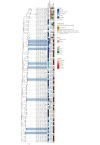Epidemiological and microbiological investigation of a large increase in vibriosis, northern Europe, 2018
- PMID: 35837965
- PMCID: PMC9284918
- DOI: 10.2807/1560-7917.ES.2022.27.28.2101088
Epidemiological and microbiological investigation of a large increase in vibriosis, northern Europe, 2018
Abstract
BackgroundVibriosis cases in Northern European countries and countries bordering the Baltic Sea increased during heatwaves in 2014 and 2018.AimWe describe the epidemiology of vibriosis and the genetic diversity of Vibrio spp. isolates from Norway, Sweden, Denmark, Finland, Poland and Estonia in 2018, a year with an exceptionally warm summer.MethodsIn a retrospective study, we analysed demographics, geographical distribution, seasonality, causative species and severity of non-travel-related vibriosis cases in 2018. Data sources included surveillance systems, national laboratory notification databases and/or nationwide surveys to public health microbiology laboratories. Moreover, we performed whole genome sequencing and multilocus sequence typing of available isolates from 2014 to 2018 to map their genetic diversity.ResultsIn 2018, we identified 445 non-travel-related vibriosis cases in the study countries, considerably more than the median of 126 cases between 2014 and 2017 (range: 87-272). The main reported mode of transmission was exposure to seawater. We observed a species-specific geographical disparity of vibriosis cases across the Nordic-Baltic region. Severe vibriosis was associated with infections caused by Vibrio vulnificus (adjOR: 17.2; 95% CI: 3.3-90.5) or Vibrio parahaemolyticus (adjOR: 2.1; 95% CI: 1.0-4.5), age ≥ 65 years (65-79 years: adjOR: 3.9; 95% CI: 1.7-8.7; ≥ 80 years: adjOR: 15.5; 95% CI: 4.4-54.3) or acquiring infections during summer (adjOR: 5.1; 95% CI: 2.4-10.9). Although phylogenetic analysis revealed diversity between Vibrio spp. isolates, two V. vulnificus clusters were identified.ConclusionShared sentinel surveillance for vibriosis during summer may be valuable to monitor this emerging public health issue.
Keywords: emerging pathogens; global warming; heatwaves; seawater; vibriosis.
Conflict of interest statement
Figures





References
-
- Frank C, Littman M, Alpers K, Hallauer J. Vibrio vulnificus wound infections after contact with the Baltic Sea, Germany. Euro Surveill. 2006;11(8):E060817.1. - PubMed
MeSH terms
LinkOut - more resources
Full Text Sources
Miscellaneous
